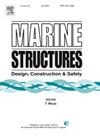Data-driven topology-fiber shape optimization method for CFRP-winding buckle arrestor based on MG-cGAN
IF 5.1
2区 工程技术
Q1 ENGINEERING, CIVIL
引用次数: 0
Abstract
To enhance the performance of deep-sea pipeline CFRP-winding buckle arrestors, this paper innovatively proposes a CFRP arrestor through joint topology-fiber shape optimization (TFSO). For the high cost of traditional joint optimization, a Multi-Generator conditional Generative Adversarial Network (MG-cGAN) is proposed to enable rapid TFSO prediction without iteration under limited high-cost TFSO dataset. Considering CFRP arrestor’s structural characteristics, the Bi-directional Evolutionary Structural Optimization (BESO) and Nondominated Sorting Genetic Algorithm III (NSGA-III) methods are sequentially employed for topology optimization (TO) and fiber shape optimization (FSO) to yield an improved structure form. Next, MG-cGAN method is used to construct a TFSO prediction model. In offline phase, TO and FSO prediction models are developed using Enhanced Structural Optimization Prediction Residual Network (ESOP-ResNet) based on single-form optimization results. In online phase, a TFSO prediction model is developed by combining TO and FSO predictions, with the model outputs treated as fake and limited serial TFSO results treated as real for adversarial training. Case studies demonstrate that the jointed optimized CFRP arrestor achieves a 25 % increase in arresting efficiency while reducing 40 % volume. Furthermore, MG-cGAN, coupled with ESOP-ResNet, significantly enhances optimization efficiency while maintaining high prediction accuracy, avoiding the substantial cost of constructing large TFSO result datasets.
基于MG-cGAN的cfrp绕扣避雷器数据驱动拓扑光纤形状优化方法
为提高深海管道CFRP缠绕扣式避雷器的性能,创新性地提出了一种基于关节拓扑-纤维形状优化(TFSO)的CFRP避雷器。针对传统联合优化的高成本问题,提出了一种多生成器条件生成对抗网络(MG-cGAN),在有限的高成本TFSO数据集下,实现无需迭代的快速TFSO预测。针对CFRP避雷器的结构特点,依次采用双向进化结构优化(BESO)和非支配排序遗传算法III (NSGA-III)方法进行拓扑优化(TO)和纤维形状优化(FSO),得到改进的结构形式。其次,采用MG-cGAN方法构建TFSO预测模型。在离线阶段,采用基于单形式优化结果的增强型结构优化预测残余网络(Enhanced Structural Optimization prediction Residual Network, ESOP-ResNet)建立了TO和FSO预测模型。在在线阶段,将TO和FSO预测相结合,建立了TFSO预测模型,将模型输出作为假值,将有限序列TFSO结果作为真实值进行对抗性训练。案例研究表明,节理型优化CFRP拦阻器在减少40%体积的同时拦阻效率提高了25%。此外,MG-cGAN与ESOP-ResNet相结合,显著提高了优化效率,同时保持了较高的预测精度,避免了构建大型TFSO结果数据集的大量成本。
本文章由计算机程序翻译,如有差异,请以英文原文为准。
求助全文
约1分钟内获得全文
求助全文
来源期刊

Marine Structures
工程技术-工程:海洋
CiteScore
8.70
自引率
7.70%
发文量
157
审稿时长
6.4 months
期刊介绍:
This journal aims to provide a medium for presentation and discussion of the latest developments in research, design, fabrication and in-service experience relating to marine structures, i.e., all structures of steel, concrete, light alloy or composite construction having an interface with the sea, including ships, fixed and mobile offshore platforms, submarine and submersibles, pipelines, subsea systems for shallow and deep ocean operations and coastal structures such as piers.
 求助内容:
求助内容: 应助结果提醒方式:
应助结果提醒方式:


